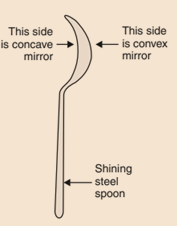Activity 10.1: Ncert book Science class 10
Introduction to Activity 10.1
Activity 10.1 in Class 10 Science NCERT Book Chapter 10, titled “Light: Reflection and Refraction,” offers an interactive and engaging way to explore the concept of image formation on curved surfaces. In this article, we’ll discuss the activity in detail, answer questions raised in the text, and outline key learning points.
The objective of Activity 10.1
The primary goal of Activity 10.1 is to help students observe and understand how images are formed on different surfaces of the spoon. The activity demonstrates the properties of images formed on convex and concave surfaces and invites students to compare these characteristics.
A spoon has two shining surfaces that refract the light that falls on it. In other terms, it acts as a mirror. The inward surface of the mirror acts as a concave mirror, while the outward surface works as a convex mirror.
Materials Required
To perform Activity 10.1, you’ll need the following materials:
A large shining spoon with a curved surface, preferably made of stainless steel or similarly reflective material.

Procedure for Activity 10.1
Follow these steps to carry out the activity:
- Hold the spoon’s concave side (inner curved surface) towards your face and observe the image formed. Notice the size and characteristics of the image.
- Slowly move the spoon away from your face, observing any changes in the image.
- Turn the spoon around so that the convex side (outer curved surface) is facing your face. Observe the image formed and note its characteristics.
- Move the spoon away from your face once again, observing any changes in the image.
- Compare the images formed on the two different surfaces.
Observations and Findings
- When viewing your face on the concave side of the spoon, you will observe an image that is real, inverted, and diminished.
- As you move the spoon away from your face, the image gradually becomes smaller.
- When you view your face on the convex side of the spoon, you will see an image that is virtual, erect, and diminished.
- As you move the spoon away from your face while observing the convex side, the image continues to get smaller or point sized as we keep on moving further.
Comparing Characteristics of Images on Concave and Convex Surfaces
The primary difference between the images formed on concave and convex mirror lies in their size and whether the image is real or virtual.
For concave side
| Face Position Relative to Spoon | Image Characteristics |
|---|---|
| At the focus (F) | Highly enlarged, inverted, formed at infinity |
| Between focus (F) and center of curvature (C) | Enlarged, inverted |
| At the center of curvature (C) | Inverted, the same size as the object |
| Beyond the center of curvature (C) | Diminished, inverted |
| Far away from the spoon | Highly diminished, inverted |
So image formed by a concave mirror is real and inverted except for the case when the object is between the pole and focus. The image would be enlarged when the position of the object is in between the center of curvature and focus and in between the pole and focus. The image will be highly enlarged when the object is placed at the focus.
For convex side
| Action with Convex Mirror | Image Characteristics |
|---|---|
| Observing the face in the spoon | Virtual, diminished, and erect |
| Moving the spoon away from the face | Image remains virtual, erect, and diminished |
In the case of a convex mirror, the image will be virtual, erect, and diminished.
Conclusion
Activity 10.1 offers a practical and interactive way for students to understand the concepts of reflection and refraction on curved surfaces. By observing the images formed on the concave and convex surfaces of a spoon, students gain a deeper understanding of the principles that govern image formation in various optical devices, such as mirrors, lenses, telescopes, and microscopes. This hands-on activity helps students visualize and internalize the concepts discussed in the chapter, thereby enhancing their learning experience.
Questions related to activity 10.1 class 10 science
- Question: What type of image is formed when our face is at the focus of a concave mirror?
Answer: When the face is at the focus of a concave mirror, a highly enlarged and inverted image is formed at infinity. - Question: How does the image change when our face is between the focus and the center of curvature of a concave mirror?
Answer: When the face is between the focus and the center of curvature of a concave mirror, the image formed is enlarged and inverted. - Question: What happens to the image when our face is at the center of curvature of a concave mirror?
Answer: When the face is at the center of curvature of a concave mirror, an inverted image of the same size as the object is formed. - Question: What type of image is formed when viewing our face in a convex mirror?
Answer: When observing our face in a convex mirror, a virtual, diminished, and erect image is formed. - Question: How does the image change when moving a convex mirror away from our face?
Answer: When moving a convex mirror away from the face, the image remains virtual, erect, and diminished.